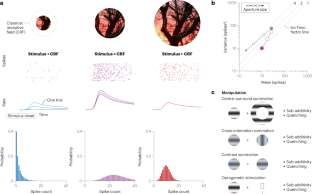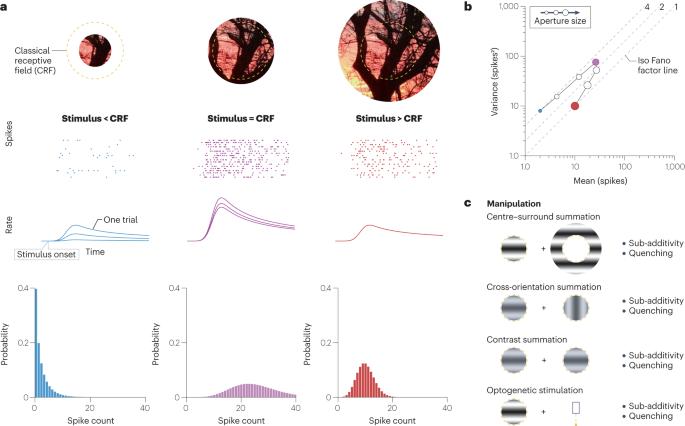Response sub-additivity and variability quenching in visual cortex
IF 28.7
1区 医学
Q1 NEUROSCIENCES
引用次数: 0
Abstract
Sub-additivity and variability are ubiquitous response motifs in the primary visual cortex (V1). Response sub-additivity enables the construction of useful interpretations of the visual environment, whereas response variability indicates the factors that limit the precision with which the brain can do this. There is increasing evidence that experimental manipulations that elicit response sub-additivity often also quench response variability. Here, we provide an overview of these phenomena and suggest that they may have common origins. We discuss empirical findings and recent model-based insights into the functional operations, computational objectives and circuit mechanisms underlying V1 activity. These different modelling approaches all predict that response sub-additivity and variability quenching often co-occur. The phenomenology of these two response motifs, as well as many of the insights obtained about them in V1, generalize to other cortical areas. Thus, the connection between response sub-additivity and variability quenching may be a canonical motif across the cortex. Sub-additive responses to simultaneously presented stimuli and quenching of variability in responses to repeated presentations of a stimulus are characteristics of neurons in the primary visual cortex. In this Perspective, Goris et al. argue that these phenomena often co-occur and may have common mechanistic and computational origins.


视觉皮层中的反应次累加性和变异性淬火
次相加性和可变性是初级视觉皮层(V1)中无处不在的反应主题。反应的次相加性有助于构建对视觉环境的有用解释,而反应的可变性则表明了限制大脑精确完成这项工作的因素。越来越多的证据表明,引起反应次相加性的实验操作往往也会抑制反应变异性。在此,我们将概述这些现象,并指出它们可能有共同的起源。我们讨论了实证研究结果以及最近基于模型对 V1 活动的功能操作、计算目标和电路机制的见解。这些不同的建模方法都预测,反应次相加性和变异性淬灭经常会同时出现。这两种反应模式的现象以及在 V1 中获得的有关它们的许多见解可以推广到其他皮层区域。因此,反应亚加性和变异性淬灭之间的联系可能是整个大脑皮层的典型模式。
本文章由计算机程序翻译,如有差异,请以英文原文为准。
求助全文
约1分钟内获得全文
求助全文
来源期刊

Nature Reviews Neuroscience
NEUROSCIENCES-
自引率
0.60%
发文量
104
期刊介绍:
Nature Reviews Neuroscience is a multidisciplinary journal that covers various fields within neuroscience, aiming to offer a comprehensive understanding of the structure and function of the central nervous system. Advances in molecular, developmental, and cognitive neuroscience, facilitated by powerful experimental techniques and theoretical approaches, have made enduring neurobiological questions more accessible. Nature Reviews Neuroscience serves as a reliable and accessible resource, addressing the breadth and depth of modern neuroscience. It acts as an authoritative and engaging reference for scientists interested in all aspects of neuroscience.
 求助内容:
求助内容: 应助结果提醒方式:
应助结果提醒方式:


